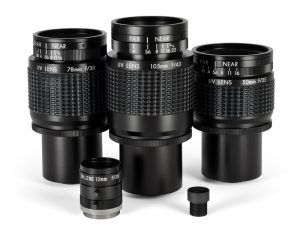High resolution lenses for machine vision — standard and custom lens design
Measuring, Defining & Capturing Images With Ultra Violet Lenses
High Resolution Lenses for machine vision, instrumentation, inspection and vibration-sensitive applications. Standard and custom hi-res lens assemblies.

Ultra Violet Lenses
Hyperspectral imaging uses available visible light, infrared light and ultraviolet light to capture images. A hyperspectral image is one that captures the entire light spectrum and captures light that isn’t visible to the naked human eye.
The human eye can process light and images in narrow ranges of light waves referred to as “visible light.” The human eye differentiates colors because your eye can sense light at varying wavelengths. Wavelengths that are outside of the range of visible light are not detectable by the human eye while visible light is the narrow range of light waves that the human eye can see.
UVA and UVB rays, those emitted by the sun, can’t be seen yet we are advised to protect our skin from these rays to prevent sunburn. The sunblock you wear prevents the UVA and UVB rays from penetrating our skin and causing sunburn and the lotion itself works within a very narrow spectrum of invisible light.
Along the lines of ultra violet light is infrared light, those used by television remotes and in infrared heat imaging of a body, these beams have a longer wavelength that extends beyond the red that we see at the end of the remote control. Infrared lights are also used in night vision goggles and cameras.
The way our eye sees and the way an ultra violet lens measures the colors of an object is that the actual color of the object, a banana for example, absorbs the light surrounding it and it reflects some of the light back; your eye picks up on the yellow color. The wavelengths of light surrounding an object are referred to as the object’s spectrum. The banana’s yellow spectrum focuses on the yellow wavelengths so you won’t see any red, for example. Also, in color spectrum and visible light, white is visible when all of the light surrounding an object gets reflected and naturally a black object reflects very little light, making it difficult for your eye to distinguish.
Centuries past, physicists discovered that all objects are made up of different molecules and that each reflects light in different ways. Once they’d determined that, the physicists developed tables to correlate the color of light that’s reflected to a particular object’s make-up. The strides that physicists made in determining the molecular composition of an object is helpful when attempting to figure out the composition of objects that are either too big, too fast, or too far away to physically capture for analysis. The way the light bounces off and reflects off an object offers physicists a clear picture of its composition.
As an example, physicists can study the sun which they know is comprised of two elements, helium and hydrogen. Because no one can physically take samples of the surface of the sun, physicists can study the composition of the sun by studying the light it emits.
Universe Optics manufactures a lens that captures images and is used in imaging applications in the non-visible light spectrum. These lenses meet the ever-increasing need for taking images in other than the visible spectrum.